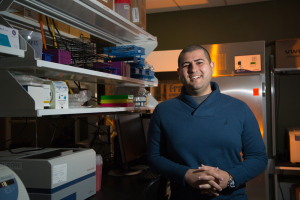Biomedical engineering student Majid Latif, a Ph.D. candidate in the May Multiscale Immunobiology Design Algorithms and Simulation (MIDAS) Lab at UH, recently won the U.S. Department of Energy’s (DOE) Office of Science Graduate Student Research award. This unique research opportunity aims to advance Latif’s overall doctoral thesis while providing him with access to the expertise, resources and capabilities available at the DOE laboratories. Latif will spend the 2016 spring semester at the Sandia National Laboratories site in Livermore, CA developing algorithms to predict gene regulation.
At the Sandia National Labs, Latif will be working with Bert Debussecher, a highly regarded computational scientist and former colleague of Latif’s faculty advisor Elebeoba May, biomedical engineering professor and director of the MIDAS Lab.
“I couldn’t be happier about Majid working with Debusschere because he’s a great colleague and Majid will benefit from the experience,” said May.
Latif brings an academically diverse background to his studies. He earned his bachelor’s degree in mathematics with a minor in philosophy from the University of Houston in 2012. He then went on to earn a master’s degree in applied cognition and neuroscience at the University of Texas in Dallas before returning to his alma mater for his doctoral studies in biomedical engineering.
Latif unearthed his passion for machine learning and algorithm development while working on his master’s degree – a passion that continues to drive his research. He said he was drawn to the Cullen College’s biomedical engineering program because biological systems, which are inherently chaotic, provided a unique challenge for him.
Latif began working in May’s lab in early 2014, though they first met when he took her Quantitative Systems Biology class, a complex course that introduces students to computational and mathematical techniques for modeling biological systems. As a result of Latif’s dedication to understanding the topics presented in the class and his overall interest in applying mathematics to biological systems, May invited him to join her research team.
May strives to cultivate collaboration and multifaceted learning in her lab by bringing together students of various academic backgrounds. Her research team includes students with backgrounds in biomedical engineering, biochemistry, biology, mathematics, and post-doctoral scientists with expertise in applied mathematics and molecular biology. Latif said he enjoys the highly interdisciplinary approach to research and the diversity of the team.
“We’re able to work together as a ‘melting pot’ and really help each other,” he said.
With the guidance of May, who believes that biology is the next engineering frontier, Latif is exploring novel questions at the intersection of computational and experimental biology through his research.
Latif won the DOE fellowship for his proposed work on developing an algorithm that describes the behavior of gene networks that regulate behavior in an Escherichia coli community. His research is part of a larger National Science Foundation Early Concept Grant for Exploratory Research project in May’s lab.
Genetic networks control the synthesis of proteins and enzymes that catalyze biomolecular reactions in living systems. In order to build such an algorithm, Latif must capture the impact of the extracellular and intracellular environments that impact these interactions and effectively use them to predict accurate future behaviors.
However, one of the major challenges facing Latif is the lack of sufficient published time course data sets for inferring and testing models. Because of this, part of Latif’s dissertation research is to contribute to the generation of the types of data sets needed for his work. Additionally, to facilitate the development, testing and validation of his algorithms, he has constructed an agent-based model (ABM) of E. coli biofilm formation that simulates a bacteria’s interaction with itself, other bacteria, and its environment. The ABM provides insight at the intracellular, extracellular and cellular levels for each bacterium in the biofilm community.
Despite the challenges of generating novel data and developing new mathematical frameworks, the novelty of this research project and the potential to break new ground is exciting and inspirational for both Latif and May.
“As a computational scientist, I’m interested in doing foundational work. I can make a difference in [biological research] by defining and describing something that really hasn’t been done before,” said Latif.
Latif also said he hopes that his modeling protocols will have a life beyond his research and will serve as tools for future scientists and researchers. Ultimately, he would like to generate an accessible “toolbox” containing catalogued modeling protocols that will serve as an evolving scientific resource.
As May explained, “it’s a high-risk, high-reward project.”
